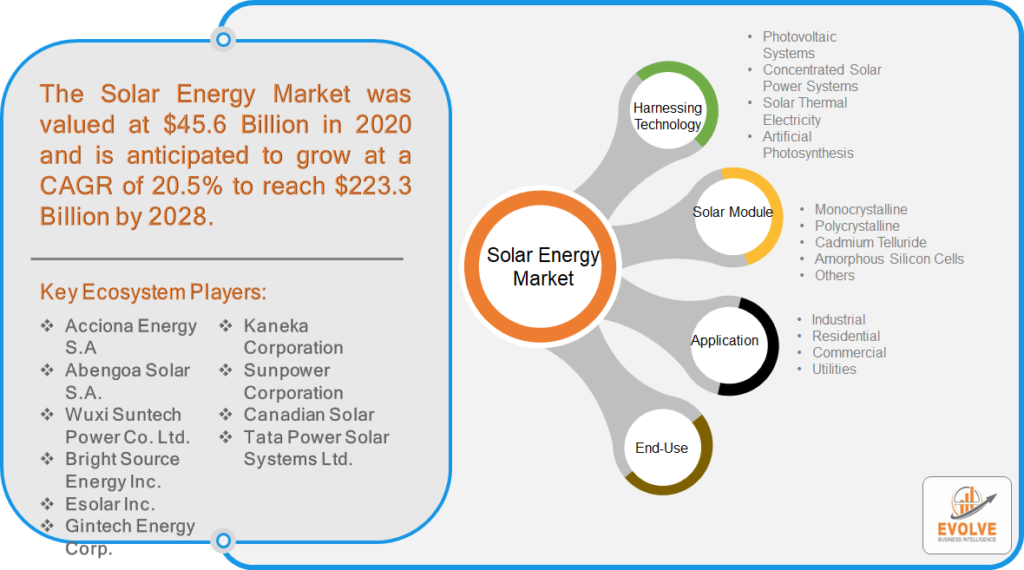The global Solar Energy market size is projected to reach approximately $223.3 Billion by 2030, at a CAGR of 20.5% from 2022 to 2030. Solar energy is the radiant energy that is harnessed from the sun by using different types of technologies such as photovoltaic cells, and solar heating cells, among various others. Solar energy is a renewable type of energy and is an excellent solution to the increasing problem of global warming and greenhouse emissions. Solar energy is an ideal long-term source of energy since it is available in abundance and for free as well as it is a cleaner form of energy as compared to oil, coal, and gas. Solar energy is becoming increasingly popular and is now used in the industrial, commercial, and residential sectors as well.
COVID-19 Impact Analysis
Due to the COVID-19, many countries around the world have been placed under lockdowns and this has resulted in disrupting supply chains, suspending most of the projects, and leading to a deterioration of their economies. Many inverters and other solar devices in India are imported from China since local production is unable to keep up with demand. A lot of these projects are getting delayed due to the ongoing border lockdown, which has created a backlog for orders of this equipment. For instance, in 2020 the government of Seychelles delayed the construction of a floating solar photovoltaic power plant because of the epidemic.
Market Dynamics
The factors driving the growth of the global Solar Energy market include rising environmental pollution and a reduction in water footprint associated with solar energy systems. Furthermore, tax rebates for solar panel installation and provision of government incentives, and a drastic increase in solar panel installations also contribute to the growth.
Drivers
Ø Development of Photovoltaic (PV) storage systems
Solar photovoltaic is the most commonly used system to convert solar energy into electrical energy. The advancements in photovoltaic storage systems raise the ability of photovoltaic systems to replace the existing conventional sources. Photovoltaic energy is preferred over concentrated solar as its utility is high. Due to the increase in the demand for photovoltaic installations, the adoption of a storage grid is expected to grow which further boosts the demand for the lithium-ion-powered battery for solar energy storage, therefore, contributing to the growth of the solar energy market.
Restraint:
Ø Difficulties in Selection of Land for Large Scale Solar Projects
Major solar projects like large utility plants or industrial plants require large land areas. In addition, the land selection is constrained by the availability of solar radiation or other factors. Installing solar projects in agricultural or forest land can be hard because of a lack of visibility, which would make it difficult to install panels. The soil might also be unstable in these areas. Land selection is also influenced by factors like transportation of equipment and the distance between the turbine and the power grid.
Opportunity:
⮚ Growing Demand for Renewable and Clean Energy
The rapid industrialization and urbanization, as well as the growing population, are driving the demand for solar energy systems which is due to the high levels of pollution caused by conventional resources which include oil, coal, gas, and fossil fuels. In addition to this, conventional sources are non-renewable and are being depleted at an alarming rate. The quality of air is also declining drastically which increases health issues for people living in the heavily polluted areas such as cities in China and India. Solar energy is the most suitable alternative since solar energy does not get depleted and also does cause pollution thus driving the growth of the solar energy market.
Segment Overview
By Harnessing Technology
Based on the Harnessing Technology, the Solar Energy market is segmented based on Photovoltaic Systems, Concentrated Solar Power Systems, Solar Thermal Electricity, and Artificial Photosynthesis. The Photovoltaic Systems segment is anticipated to account for the large market share. Photovoltaic Systems has had the most innovations and price reductions among all solar technologies. Over the past few years, there have been certain trends related to solar PV technology: a reduction in costs, an increase in the global market share of manufacturers from China, and a reduction in profit margins. Some other trends have been vertical integration of PV components etc.
By Solar Module
Based on the Solar Module, the Solar Energy market is segmented based on Monocrystalline, Polycrystalline, Cadmium Telluride, Amorphous Silicon Cells, and Others. The Monocrystalline segment is anticipated to account for the large market share. Monocrystalline solar panels are expected to become the most profitable type of solar panels in the years to come due to their increasing use and potential for growth in the residential sector. Monocrystalline cells allow for higher efficiency and smaller size.
By Application
Based on Application, the global Solar Energy market has been divided into Industrial, Residential, Commercial, and Utilities. The Residential segment is expected to hold the largest market share. The amount of residential solar installations is expected to grow significantly in the next decade. This is due to an increase in government support for renewable energy, as well as a decrease in solar panel prices. This has led to more and more homeowners choosing this type of installation for their homes.
By End-Use
Based on End-User, the global Solar Energy market has been divided into Electricity Generation, Heating, Charging, and Lighting. Electricity generation is the segment with the largest market share, as urbanization and demand for electricity are high in developing countries. Rising government initiatives to adopt more clean energy will also drive demand for solar power generation.
Global Solar Energy Market Share, by Segmentation
Regional Analysis
Based on region, the global Solar Energy market has been divided into North America, Europe, Asia-Pacific, and the Rest of the World. North America and Europe are projected to dominate the use of the Solar Energy market followed by the Asia-Pacific region.
North America and Europe Market
North America and Europe together dominate the solar energy market due to rising awareness about environmental conservation as well as favorable government initiatives. In addition to this, growing demand from countries such as Canada, U.S. Germany, and France further boosts the growth of the solar energy market in this region. The development of photovoltaic storage systems coupled with the top-notch PV research and development structure additionally contributes to the growth of the market in Europe and North America.
Asia-Pacific Market
The Asia Pacific region is expected to exhibit a significant growth rate over the next seven years due to increasing installation in China, India, and Japan. These countries are the most populated in the world and are predicted to invest heavily in energy markets. Feed-in-tariff and the Jawaharlal Nehru National Solar Mission in India are policies that have been making a positive impact and will continue to fuel solar installation.
Competitive Landscape
The market comprises tier-1, tier-2, and local players. With their wide product portfolios, tier-1 and tier-2 players have a global reach. Because of their strategic innovations and broad regional presence, companies such as Acciona Energy S.A, Abengoa Solar S.A., Wuxi Suntech Power Co. Ltd., Bright Source Energy Inc., Esolar Inc., Gintech Energy Corp., Kaneka Corporation, Sunpower Corporation, Canadian Solar, and Tata Power Solar Systems Ltd., lead the global Solar Energy business. To increase their market position and attract a wide consumer base, the businesses are employing various strategies, such as growth, product releases, and alliances.
Prominent Players:
- Acciona Energy S.A
- Abengoa Solar S.A.
- Wuxi Suntech Power Co. Ltd.
- Bright Source Energy Inc.
- Esolar Inc.
- Gintech Energy Corp.
- Kaneka Corporation
- Sunpower Corporation
- Canadian Solar
- Tata Power Solar Systems Ltd.
In July 2019, Tata Power Solar Systems Ltd. entered into a partnership agreement with NTT Com- Netmagic to provide IT solutions for their new 50MW solar photovoltaic power plant in Maharashtra.
Scope of the Report
Global Solar Energy Market, by Harnessing Technology
- Photovoltaic Systems
- Concentrated Solar Power Systems
- Solar Thermal Electricity
- Artificial Photosynthesis
Global Solar Energy Market, by Solar Module
- Monocrystalline
- Polycrystalline
- Cadmium Telluride
- Amorphous Silicon Cells
- Others
Global Solar Energy Market, by Application
- Industrial
- Residential
- Commercial
- Utilities
Global Solar Energy Market, by End-Use
- Electricity Generation
- Lighting
- Heating
- Charging
Global Solar Energy Market, by Region
- North America
- US
- Canada
- Mexico
- Europe
- UK
- Germany
- France
- Italy
- Rest of Europe
- Asia Pacific
- China
- Japan
- South Korea
- India
- Rest of Asia Pacific
- Rest of the World
| Parameters | Indicators |
|---|---|
| Market Size | 2030: $ $ 223.3 Billion |
| CAGR | 20.5% CAGR (2022-2030) |
| Base year | 2021 |
| Forecast Period | 2022-2030 |
| Historical Data | 2020 |
| Report Coverage | Revenue Forecast, Competitive Landscape, Growth Factors, and Trends |
| Key Segmentations | Harnessing Technology, Solar Module, Application, and End-Use |
| Geographies Covered | North America, Europe, Asia-Pacific, Latin America, Middle East, Africa |
| Key Vendors | Acciona Energy S.A, Abengoa Solar S.A., Wuxi Suntech Power Co. Ltd., Bright Source Energy Inc., Esolar Inc., Gintech Energy Corp., Kaneka Corporation, Sunpower Corporation, Canadian Solar, and Tata Power Solar Systems Ltd. |
| Key Market Opportunities | Growing Demand for Renewable and Clean Energy |
| Key Market Drivers | Development of Photovoltaic (PV) storage systems |
REPORT CONTENT BRIEF:
- High-level analysis of the current and future Solar Energy market trends and opportunities
- Detailed analysis of current market drivers, restraining factors, and opportunities in the future
- Solar Energy market historical market size for the year 2020, and forecast from 2021 to 2028
- Solar Energy market share analysis at each product level
- Competitor analysis with a detailed insight into its product segment, financial strength, and strategies adopted.
- Identifies key strategies adopted including product launches and developments, mergers and acquisitions, joint ventures, collaborations, and partnerships as well as funding taken and investment done, among others.
- To identify and understand the various factors involved in the global Solar Energy market affected by the pandemic
- To provide a detailed insight into the major companies operating in the market. The profiling will include the financial health of the company past 2-3 years with segmental and regional revenue breakup, product offering, recent developments, SWOT analysis, and key strategies.





